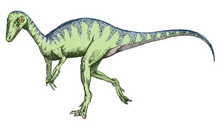Eoraptor
| Eoraptor Temporal range: Middle Triassic,
| |
|---|---|

| |
| Replica skeleton in Brussels | |
| Scientific classification | |
| Missing taxonomy template (fix): | Eoraptor lunensis |
Eoraptor was one of the world's earliest dinosaurs. It was a two-legged saurischian, either a theropod,[1][2] or, according to some investigatiors, a sauropodomorph.[3] It lived ca. 231.4 million years ago,[4] in what is now the northwestern region of Argentina. The type species is Eoraptor lunensis, which means 'dawn plunderer from the Valley of the Moon', denoting where it was originally discovered (Greek eos/ηως meaning 'dawn' or 'morning' and Latin lunensis meaning 'of the moon'). It is known from several well-preserved skeletons.
Description
Eoraptor had a thin body that grew to about 1 meter (3 ft) in length, with an estimated weight of about 10 kilograms (22 lb). It ran digitigrade, upright on its hind legs. Its fore limbs were only half the length of its hind limbs and it had five digits on each 'hand'. Three of those digits, the longest of the five, ended in large claws and were presumably used to handle prey. Scientists have surmised that the fourth and fifth digits were too tiny to be of any use in hunting.
Eoraptor is thought to have been an omnivore.[5] It was a swift sprinter and, upon catching its prey, it would use claws and teeth to tear the prey apart. It had both carnivore-type and herbivore-type teeth.
History of discovery


The bones of this primitive dinosaur were first discovered in 1991, by University of San Juan paleontologist Ricardo Martínez, during field work conducted by the University of Chicago and the University of San Juan in the Ischigualasto Basin of Argentina. During the mid Triassic Period, this was a river valley but is now desert badlands. Eoraptor was found in the Ischigualasto Formation, the same formation that yielded Herrerasaurus, a very early theropod. In 1993 paleontologist Paul Sereno and colleagues described and named the species, and determined it to be one of the earliest dinosaurs.[1] Its age was determined by several factors, not least because it lacked the specialised features of any of the major groups of later dinosaurs, including its lack of specialized predatory features. Unlike later, carnivorous dinosaurs, it lacked a sliding joint at the articulation of the lower jaw, with which to hold large prey. Furthermore, only some of its teeth were curved and saw-edged, unlike those in a later predator's mouth.
Taxonomy
Eoraptor is regarded as one of the most primitive dinosaurs.[5] The precise placement of Eoraptor within Dinosauria has been unstable, with opinion often varying between a basal saurischian and a basal theropod. When it was first described by Sereno and Forster in 1993, it was regarded as a theropod, based on its "functionally tridactyl hand" and other features.[1] In 2011, as part of the team that described Eodromaeus, Sereno and others found Eoraptor to be a basal sauropodomorph, with characteristic features for that group.[6] Michael Benton has expressed his hesitation to this, and claims that it is "quite a shift" to remove Eoraptor from the theropods to Sauropodomorpha.[6] Nesbitt and Bergman, when describing Daemonosaurus, also classified Eoraptor as a theropod.[7]
References
- ^ a b c Sereno, P., Forster, Rogers and Monetta, (1993). "Primitive dinosaur skeleton from Argentina and the early evolution of Dinosauria." Nature, 361: 64-66.
- ^ Nesbitt, S. J., Smith, N. D., Irmis, R. B., Turner, A. H., Downs, A., and M. A. Norell. 2009. A complete skeleton of a Late Triassic saurischian and the early evolution of dinosaurs. Science 326:1530-1533.
- ^ R.N. Martinez et al. A basal dinosaur from the dawn of the dinosaur era in southwestern Pangaea. Science, Vol. 331, January 14, 2011, p. 206.
- ^ Alcober, Oscar A. (2010). "A new herrerasaurid (Dinosauria, Saurischia) from the Upper Triassic Ischigualasto Formation of northwestern Argentina". ZooKeys. 63: 55–81. doi:10.3897/zookeys.63.550.
{{cite journal}}: Unknown parameter|coauthors=ignored (|author=suggested) (help)CS1 maint: unflagged free DOI (link) [1] - ^ a b Paul G.S., The Princeton Field Guide to Dinosaurs (Princeton University Press, 2010), p. 68.
- ^ a b Kaplan M, "Move over Eoraptor", http://www.nature.com/news, 13-1-2011.
- ^ Bergman D.S., Sues H-D. (2011), "A late-surviving basal theropod dinosaur from the latest Triassic of North America", Proceedings of the Royal Society B, publisched online 13-4-2011.
